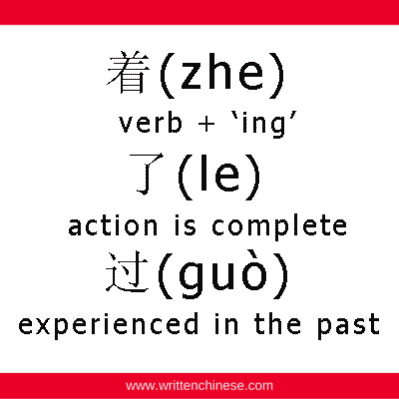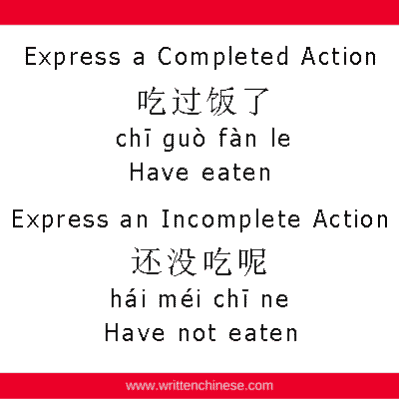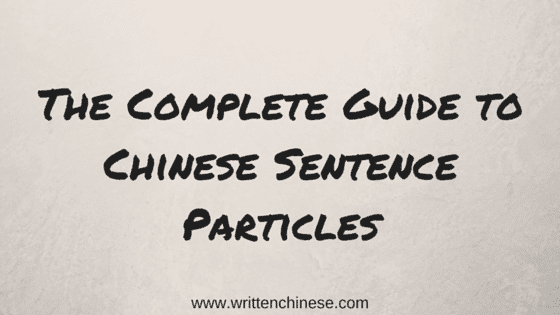This is our second article that looks at Chinese sentence particles. We will discuss structural, aspect and some other particles that do not fit into a specific category. If you want to learn about modal particles, then take a look at our first article, The Complete Guide to Chinese Modal Particles.
Structural particles 结构助词 (jié gòu zhù cí): 的, 地, 得 and 所
Structural particles are characters that are used to show a grammatical relationship between other words.
The first three structural particles, 的 (de), 地 (de) and 得 (de) are all the 5th tone.
的 (de) is often used between the attributive and center word
In both these examples, 的 (de) can be explained as being ‘of the’:
伟大的作家 (wěi dà de zuò jiā) great writer
讨论的结果 (tǎo lùn de jié guǒ) the outcome of the discussion
的 is often used after another word or phrase to make a noun phrase
They can be used as a subject, predicate (containing a verb) or an object:
As a subject 作主语 (zuò zhǔ yǔ):
吃的和穿的都在那儿。 (chī de hé chuān de dōu zài nar) = Things for both eating and wearing are there.
As a predicate (containing a verb) 作谓语 (zuò wèi yǔ):
这本书我买的。 (zhè běn shū wǒ mǎi de) I bought the book.
As an object 作宾语 (zuò bīn yǔ)
你的手机该换新的了。 (nǐ de shǒu jī gāi huàn xīn de le) Your mobile phone needs to be replaced with a new one.
地 (de) is often used between adverbs and center words
慢慢地走 (màn màn de zǒu) = Walk slowly
渐渐地暗下去 (jiàn jiàn de àn xià qu) = Dim gradually
得 is used after the verb and adjective
When the 得 is used after a verb, the particle is a complement.
记得很清楚 (jì de hěn qīng chu) Remember very clearly.
走得很快 (zǒu de hěn kuài) Walk very fast.
You can read more about the three ‘de’ particles, 的, 地 and 得 in our article, How to use the ‘de’ particles 的, 得 and 地 in Chinese.
所 (suǒ) is used before a transitive verb
When using the character 所 with a verb, it becomes a noun phrase, but is only used in written Chinese.
所见所闻 (suǒ jiàn suǒ wén) = What one sees and hears.
所作所为 (suǒ zuò suǒ wéi) = One’s conduct and deeds.
The noun phrase of 所 (suǒ) can also work with the particle 的 (de)
我所知道的情况就是这些。 (wǒ suǒ zhī dao de qíng kuàng jiù shì zhè xiē) All I know is that this is the situation.
他所听说的消息都假的。 (tā suǒ tīng shuō de xiāo xi dōu jiǎ de) The news that he heard is completely false.
In spoken Chinese, 所 (suǒ) can be removed from the sentence.
Aspect particles 动态助词 (dòng tài zhù cí): 着,了,过 and 来着
着 (zhe), 了 (le) and 过 (guo) are all the 5th tone, and mainly used to express the status of an action.
着 is used after the verb to express that the action is ongoing
Adverbs, such as 正 (zhèng), 在 (zài) and 正在 (zhèng zài) can be used before the verb, and the sentence often ends with the particle 呢 (ne).

比赛正在进行着。 (bǐ sài zhèng zài jìn xíng zhe.) The game is in progress.
他们正吃着饭。 (tā men zhèng chī zhe fàn) They are having a meal.
着 can be used in the present tense, past tense and future tense
Present tense:
现在雨正下着呢,你待一会儿再走。 (xiàn zài yǔ zhèng xià zhe ne, nǐ dāi yī huìr zài zǒu.) It is raining now, you can stay for a while and leave later.
Past tense:
那天他回来的时候,雨正下着呢。 (nà tiān tā huí lai de shí hòu, yǔ zhèng xià zhe ne) It was raining on the day that he returned.
Future tense:
明天早上我正开着会,哪有时间去呢? (míng tiān zǎo shang wǒ zhèng kāi zhe huì, nǎ yǒu shí jiān qù ne?) = I have a meeting tomorrow morning, how will I have time to go?
着 can be used after a verb to express the continuation of an action
If you use 着 in this way, you do NOT need to add 正, 在 or 正在 before the verb.
灯还开着呢。 (dēng hái kāi zhe ne.) = The light is still on.
她穿着一条红裙子。(tā chuān zhe yī tiáo hóng qún zi.) = She is in a red skirt.
了 can be used after a verb to express the action is complete
It can be used in present perfect tense, past or future perfect tense.
Past tense: 那天我下了课就去图书馆。(nà tiān wǒ xià le kè jiù qù tú shū guǎn.)
I went to the library once I had finished that day’s class.
Present tense: 我下了课来到了图书馆。 (wǒ xià le kè lái dào le tú shū guǎn.) = I am going to the library after my class has finished.
Future tense: 希望明天你来的时候,我已经完成了所有工作。 (xī wàng míng tiān nǐ lái de shí hòu, wǒ yǐ jīng wán chéng le suǒ yǒu gōng zuò.) I hope that when you come tomorrow, I shall have finished all the work.
了 can be used after an adjective to express a change has come true or a new situation has occurred.
头发白了。 (tóu fā bái le) = The hair has turned white.
苹果红了。 (píng guǒ hóng le) = The apple has turned red.
过 can be used after a verb to express the action has finished
吃过饭再走。 (chī guò fàn zài zǒu.) = Leave after the meal.
当我们赶到剧院的时候,第一场已经演过了。 (dāng wǒ men gǎn dào jù yuàn, dì yī chǎng yǐ jīng yǎn guò le) = After we got to the theatre, the first show had already finished.
过 can also express what has happened before
Here we will add 曾经 (céng jīng) or 已经 (yǐ jīng) before the verb.
我看过这本书。 (wǒ kàn guò zhè běn shū.) = I have read this book before.
他曾经去过中国。 (tā céng jīng qù guò zhōng guó.) = He has been to China before.
这件事已经讨论过了。 (zhè jiàn shì yǐ jīng tǎo lùn guò le.) = This issue has already been discussed.
The next two examples show how to negate a sentence that include the particle 过 (guò):

To express that an action is complete:
(chī guò fàn le) —- (hái méi chī ne)
Have had the meal —— Have not had the meal
To express something that has happened before:
(chī guò mǐ fàn) —- (méi chī guò mǐ fàn)
Have eaten rice —— Have never eaten rice
过 can also be used after an adjective to express that there was some situation in the past.
In this situation we need to define the time, which means the sentence must compare with the current situation.
前几天冷过一阵。 (qián jǐ tiān lěng guò yī zhèn) = It has been cold few the last few days.
If we negate this sentence, we need to add 从来 (cóng lái) or 过去没(有) (guò qu méi). 这么 (zhè me) is also added before the adjective.
这里从来没有这么冷过。 (zhè lǐ cóng lái méi yǒu zhè me lěng guò) =
It has never been so cold here before.
来着 (lái zhe) is always used in spoken Chinese, to express something that has happened before
来着 (lái zhe) is always used at the end of a sentence. We do NOT use 了 (le) or 过 (guo) in these sentences.
最近你都忙什么来着? (zuì jìn nǐ dōu máng shén me lái zhe.) What have you been busy with recently?
刚才他说什么来着? (gāng cái tā shuō shén me lái zhe?) What did he just say?
The Other Chinese Particles 其他助词 (qí tā zhù cí): 似的, 一样 and 一般
似的 (sì de), 一样 (yī yàng), and 一般 (yī bān) are used after words or phrases to make up comparative phrases. This are mainly used to express a metaphor or explain a situation that is similar.
她正处在花一样的年纪。 (tā zhèng chǔ zài huā yī yàng de nián jì.)
She is the same age as the flowers.
他飞也似的跑来。 (tā fēi yě sì de pǎo lái.) He running so fast it’s as though he was flying.
他几天没吃饭似的。 (tā jǐ tiān méi chī fàn sì de.) He looks like he has not eaten a meal for several days.
Don’t forget to read the first part of our ‘particle article’ on modal particles
If you have any comments or questions about Chinese sentence particles, leave them in the comment section below!
